Abstract
1. An examination of the physiological properties of cells in cat lumbar dorsal horn shows that there are three horizontal laminae which correspond approximately to Rexed (1952) laminae 4, 5, and 6.
2. A summary diagram (Fig. 9) suggests the relation of the laminae to each other and to afferent and descending fibres. All three laminae respond to cutaneous stimulation but only lamina 6 responds to movement. By comparing responses of cells in decerebrate and spinal preparations, it is shown that the brain stem inhibits cutaneous responses and enhances movement responses. Pyramidal tract stimulation affects cells in laminae 4, 5, and 6.
3. Cells in lamina 4 have small cutaneous receptive fields and respond as though many different types of specific cutaneous afferents converge on them. Cells in lamina 5 respond as though many cells of lamina 4 converge on them. In the decerebrate animal the responses of lamina 5 cells habituate to repeated light pressure stimuli but the cells remain responsive to new stimuli in other parts of their receptive field. Impulses descending from the brain stem can switch the modality of lamina 6 cells from cutaneous to proprioceptive.
Full text
PDF

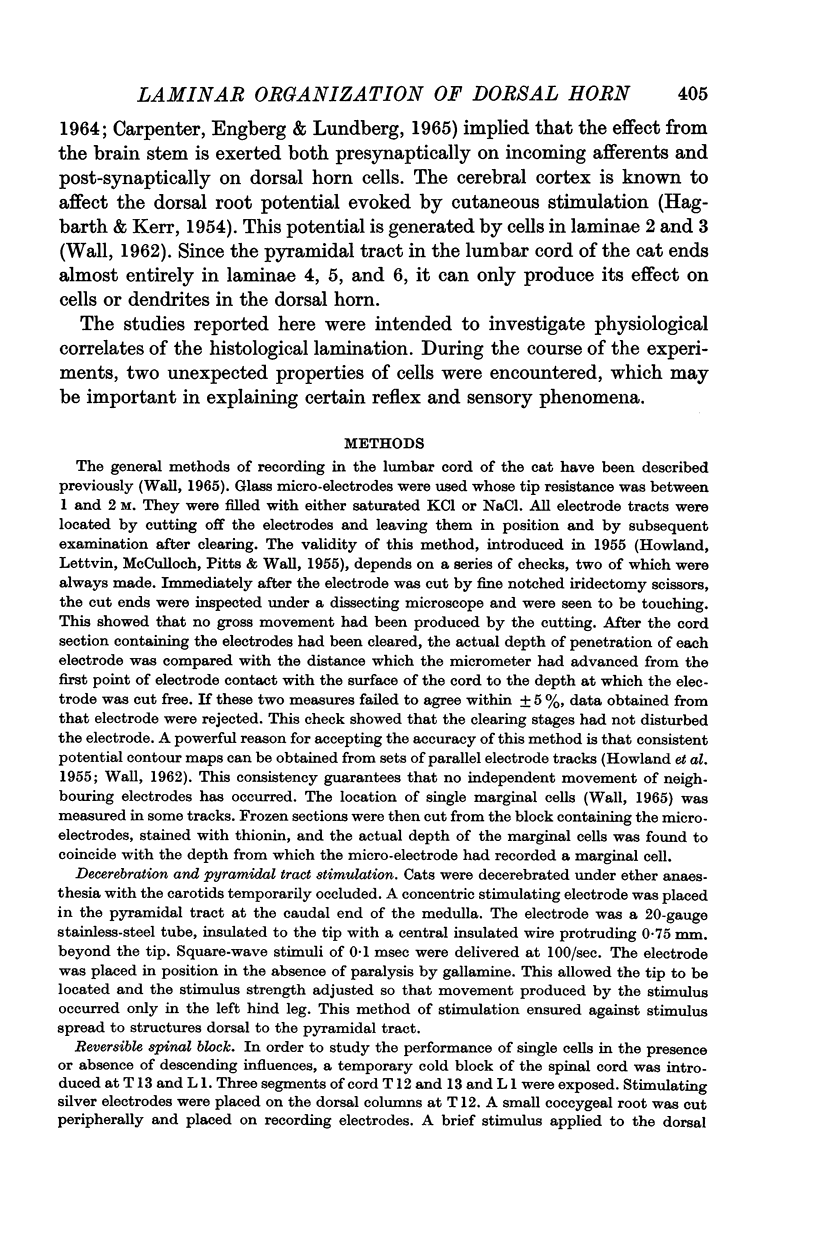



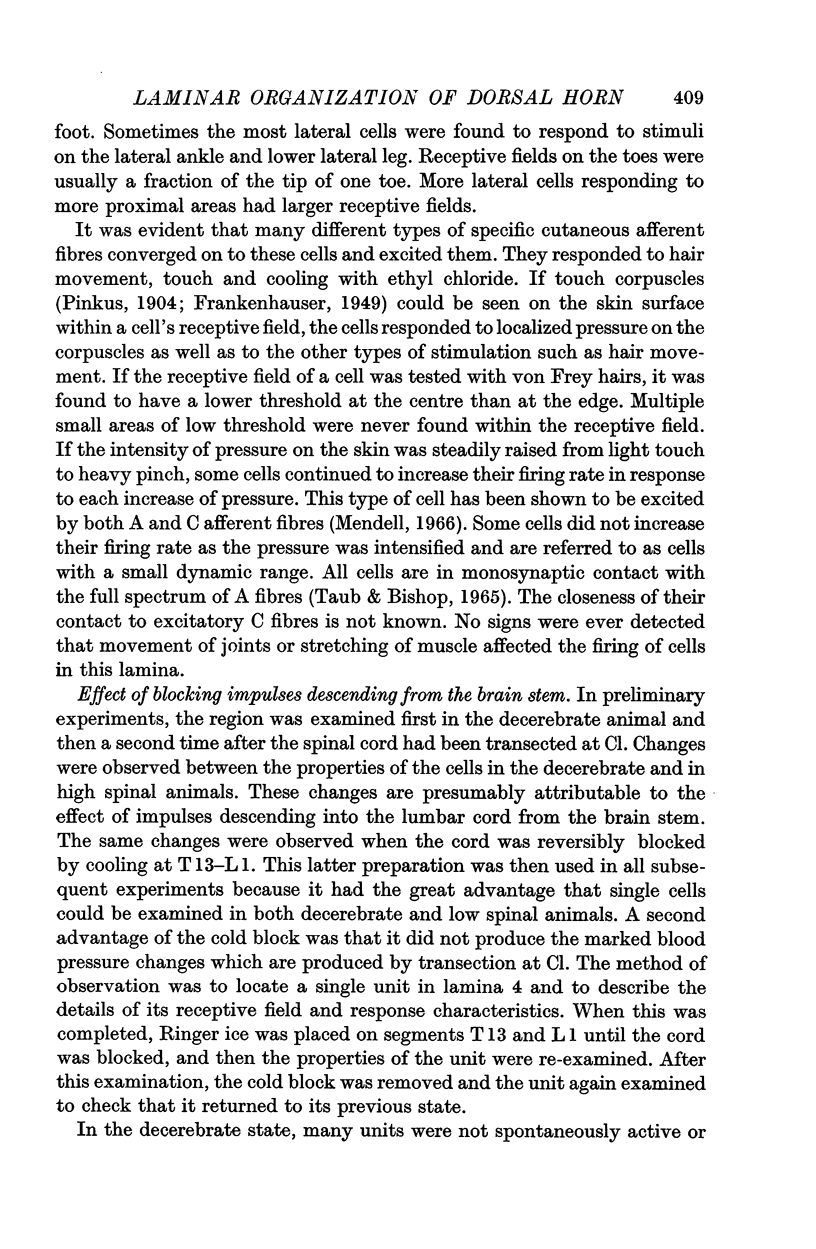





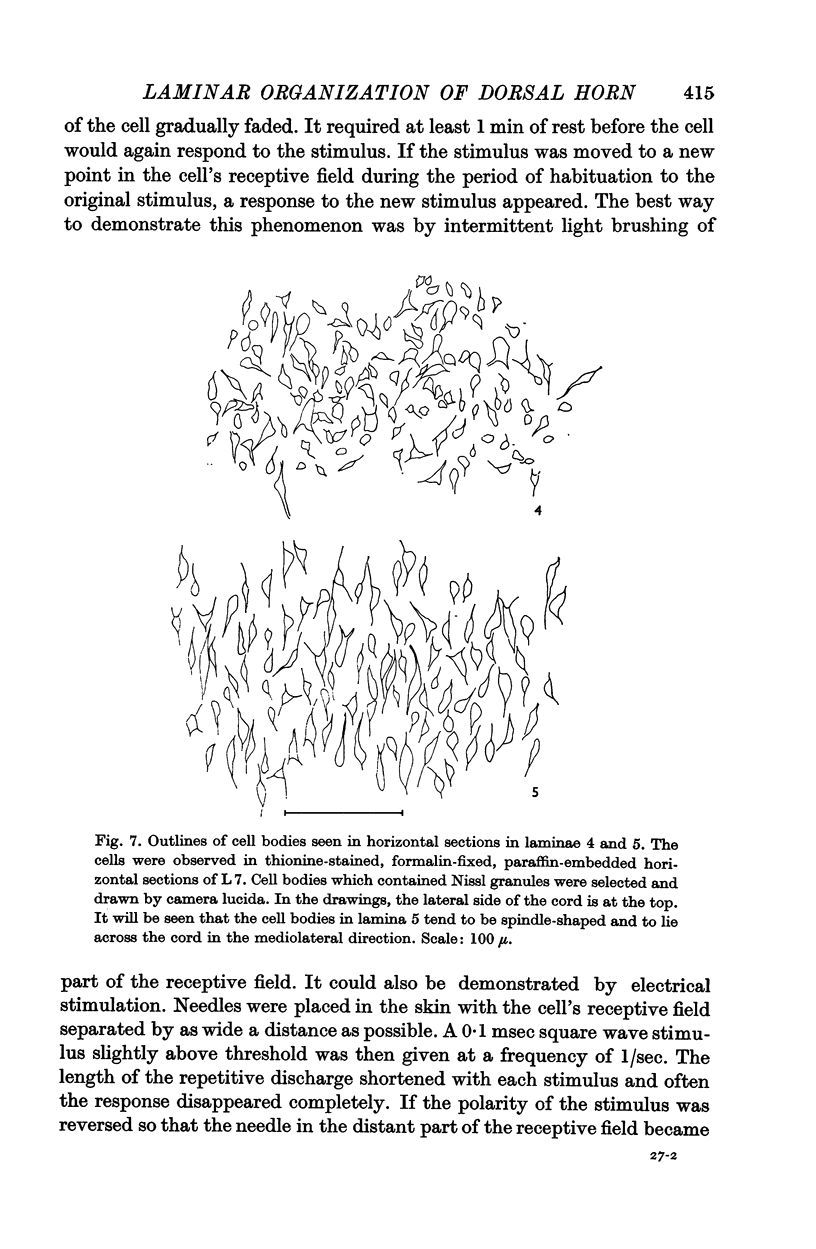



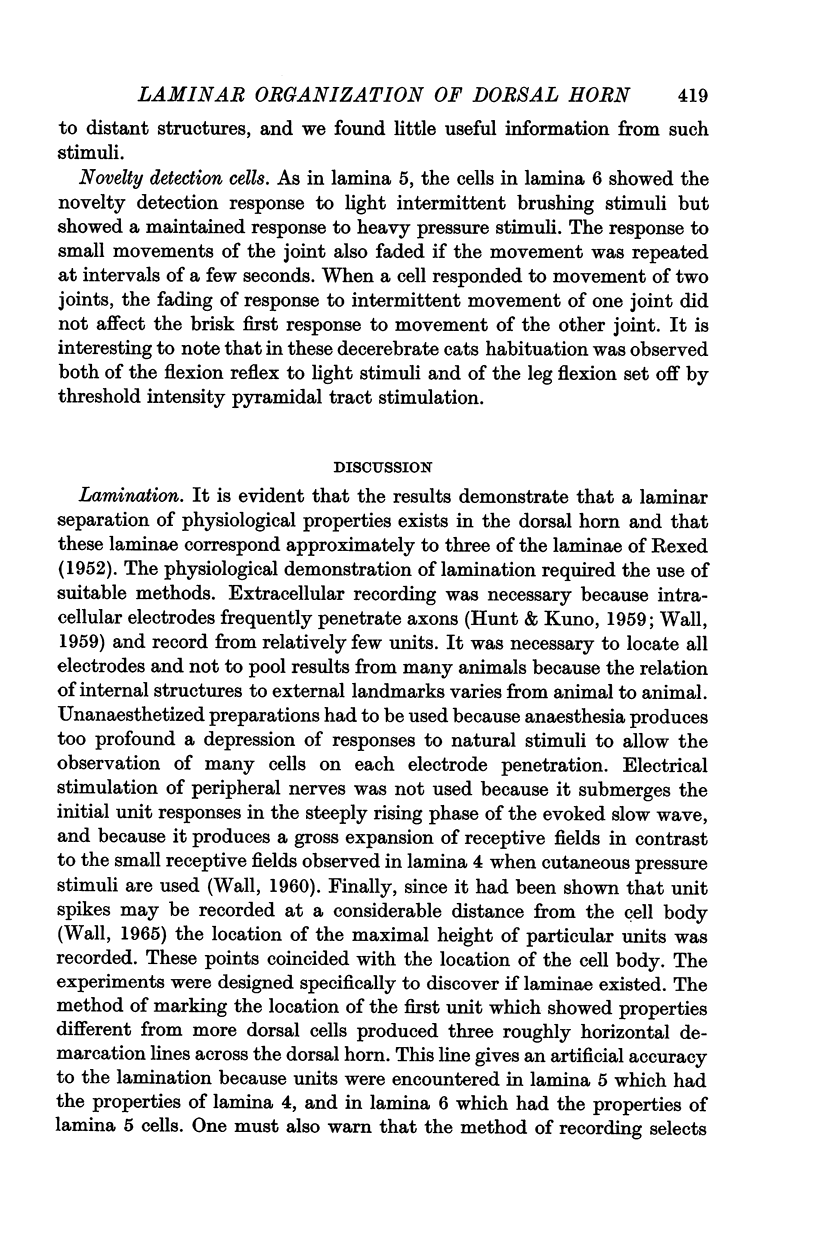

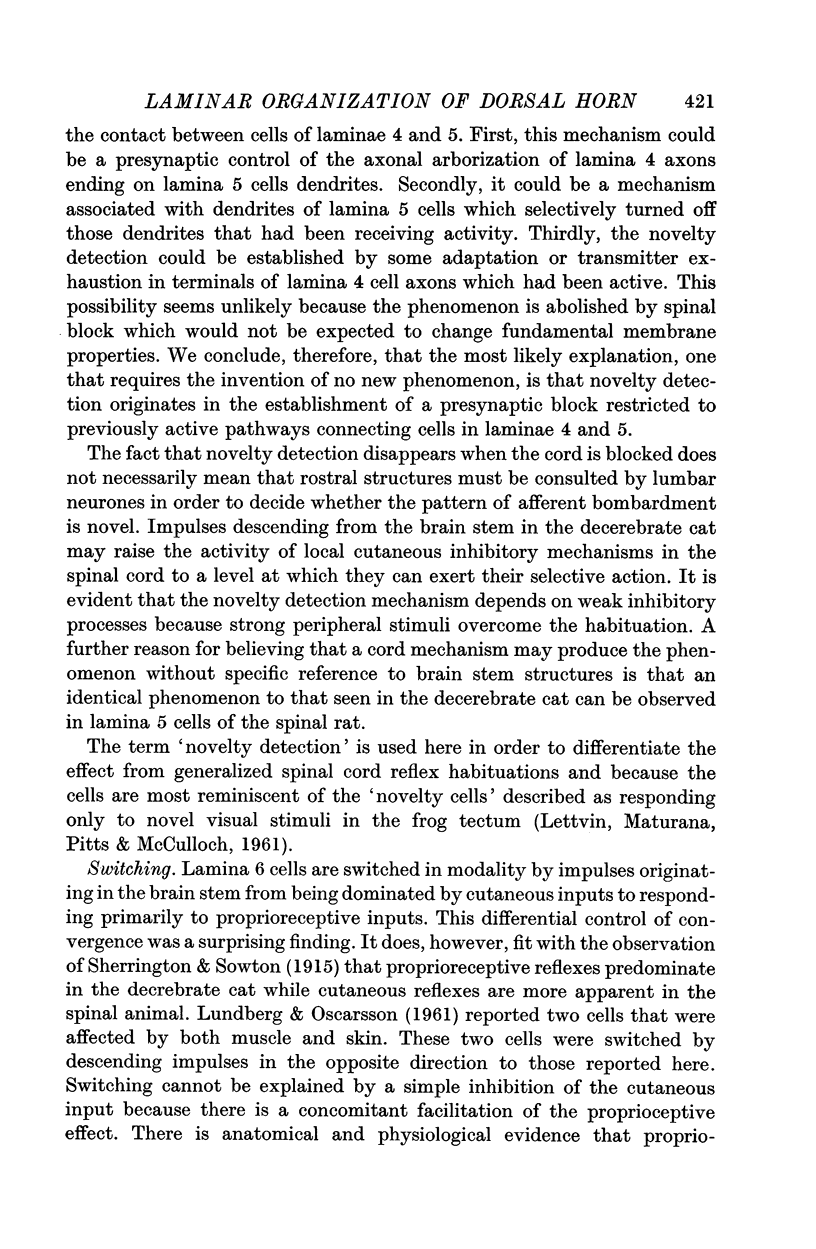
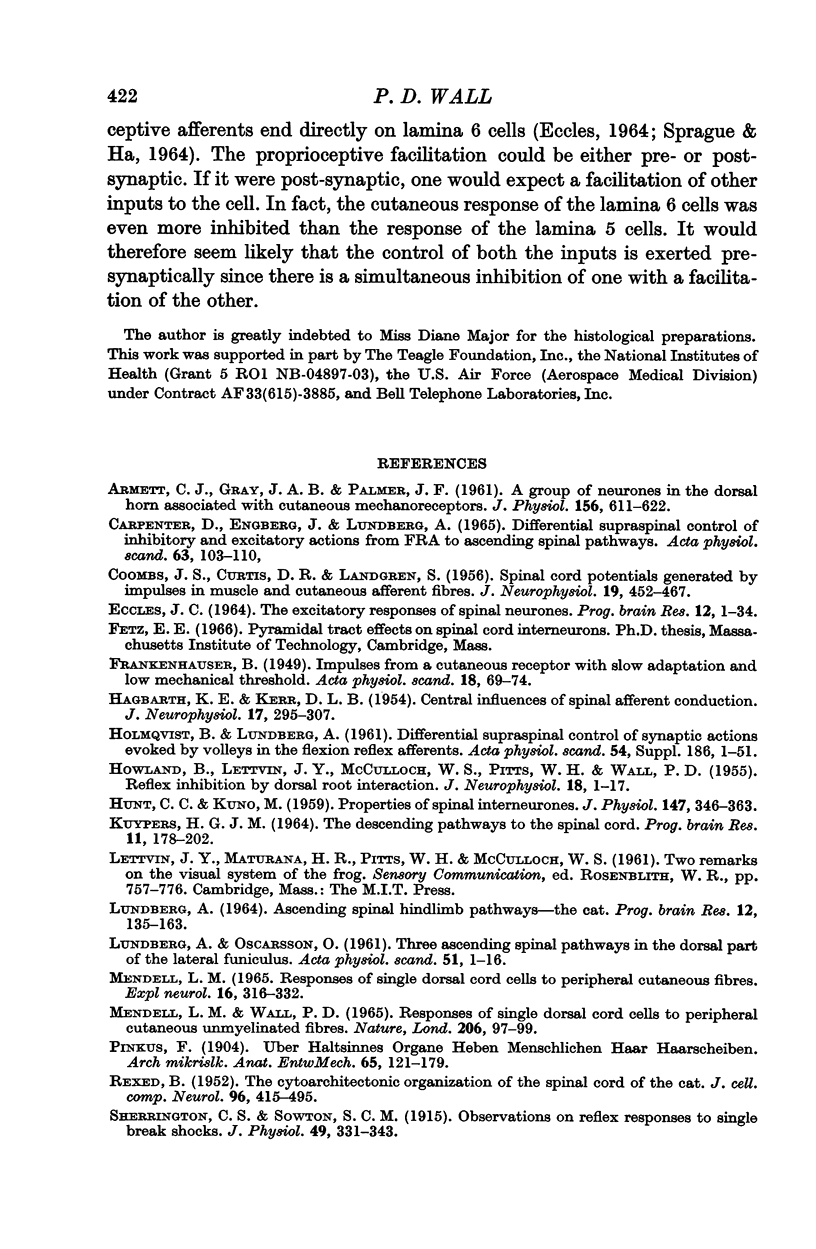
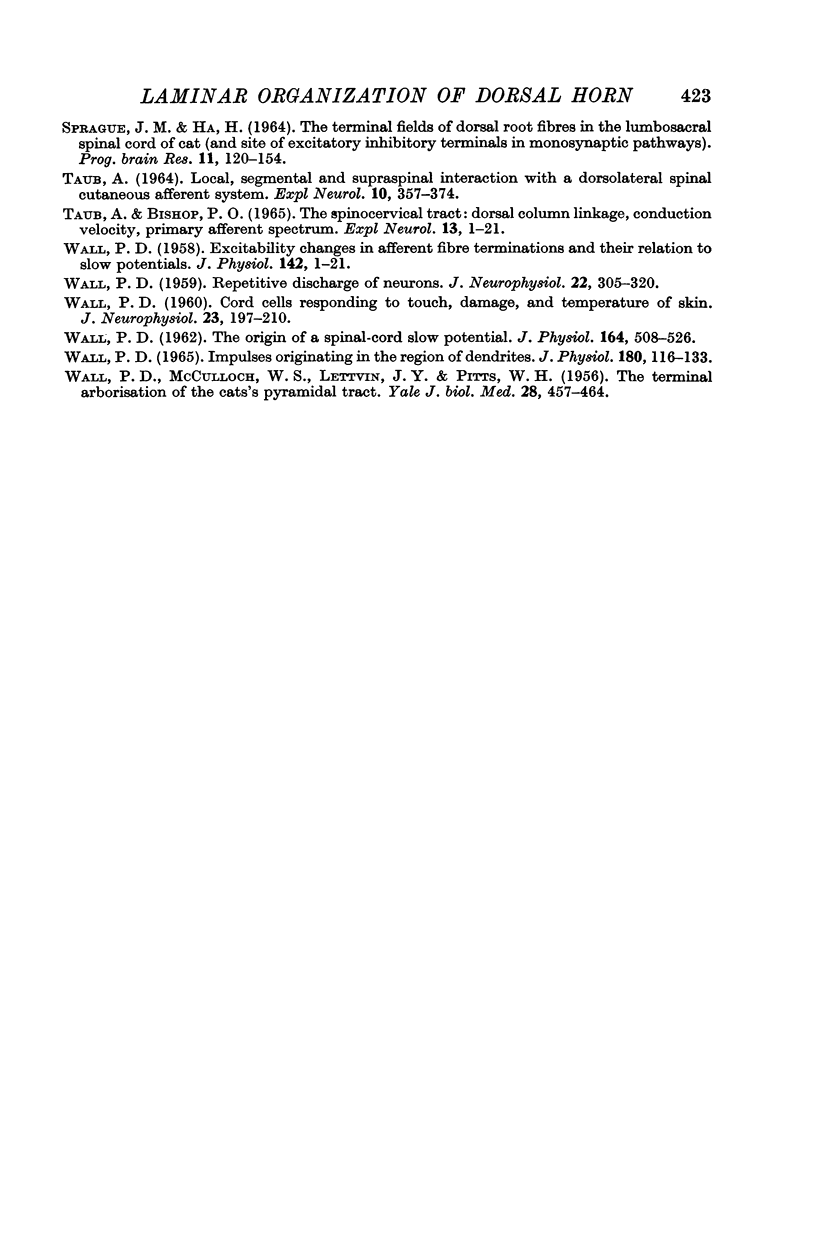
Selected References
These references are in PubMed. This may not be the complete list of references from this article.
- ARMETT C. J., GRAY J. A., PALMER J. F. A group of neurones in the dorsal horn associated with cutaneous mechanoreceptors. J Physiol. 1961 May;156:611–622. doi: 10.1113/jphysiol.1961.sp006697. [DOI] [PMC free article] [PubMed] [Google Scholar]
- CARPENTER D., ENGBERG I., LUNDBERG A. DIFFERENTIAL SUPRASPINAL CONTROL OF INHIBITORY AND EXCITATORY ACTIONS FROM THE FRA TO ASCENDING SPINAL PATHWAYS. Acta Physiol Scand. 1965 Jan-Feb;63:103–110. doi: 10.1111/j.1748-1716.1965.tb04047.x. [DOI] [PubMed] [Google Scholar]
- COOMBS J. S., CURTIS D. R., LANDGREN S. Spinal cord potentials generated by impulses in muscle and cutaneous afferent fibres. J Neurophysiol. 1956 Sep;19(5):452–467. doi: 10.1152/jn.1956.19.5.452. [DOI] [PubMed] [Google Scholar]
- ECCLES J. C. THE EXCITATORY RESPONSES OF SPINAL NEURONES. Prog Brain Res. 1964;12:1–34. doi: 10.1016/s0079-6123(08)60614-7. [DOI] [PubMed] [Google Scholar]
- HAGBARTH K. E., KERR D. I. Central influences on spinal afferent conduction. J Neurophysiol. 1954 May;17(3):295–307. doi: 10.1152/jn.1954.17.3.295. [DOI] [PubMed] [Google Scholar]
- HOWLAND B., LETTVIN J. Y., McCULLOCH W. S., PITTS W., WALL P. D. Reflex inhibition by dorsal root interaction. J Neurophysiol. 1955 Jan;18(1):1–17. doi: 10.1152/jn.1955.18.1.1. [DOI] [PubMed] [Google Scholar]
- HUNT C. C., KUNO M. Properties of spinal interneurones. J Physiol. 1959 Sep 2;147:346–363. doi: 10.1113/jphysiol.1959.sp006248. [DOI] [PMC free article] [PubMed] [Google Scholar]
- KUYPERS H. G. THE DESCENDING PATHWAYS TO THE SPINAL CORD, THEIR ANATOMY AND FUNCTION. Prog Brain Res. 1964;11:178–202. doi: 10.1016/s0079-6123(08)64048-0. [DOI] [PubMed] [Google Scholar]
- LUNDBERG A. ASCENDING SPINAL HINDLIMB PATHWAYS IN THE CAT. Prog Brain Res. 1964;12:135–163. doi: 10.1016/s0079-6123(08)60621-4. [DOI] [PubMed] [Google Scholar]
- LUNDBERG A., OSCARSSON O. Three ascending spinal pathways in the dorsal part of the lateral funiculus. Acta Physiol Scand. 1961 Jan;51:1–16. doi: 10.1111/j.1748-1716.1961.tb02108.x. [DOI] [PubMed] [Google Scholar]
- REXED B. The cytoarchitectonic organization of the spinal cord in the cat. J Comp Neurol. 1952 Jun;96(3):414–495. doi: 10.1002/cne.900960303. [DOI] [PubMed] [Google Scholar]
- SPRAGUE J. M., HONGCHIEN H. A. THE TERMINAL FIELDS OF DORSAL ROOT FIBERS IN THE LUMBOSACRAL SPINAL CORD OF THE CAT, AND THE DENDRITIC ORGANIZATION OF THE MOTOR NUCLEI. Prog Brain Res. 1964;11:120–154. doi: 10.1016/s0079-6123(08)64046-7. [DOI] [PubMed] [Google Scholar]
- Sherrington C. S., Sowton S. C. Observations on reflex responses to single break-shocks. J Physiol. 1915 Jul 5;49(5):331–348. doi: 10.1113/jphysiol.1915.sp001713. [DOI] [PMC free article] [PubMed] [Google Scholar]
- TAUB A., BISHOP P. O. THE SPINOCERVICAL TRACT: DORSAL COLUMN LINKAGE, CONDUCTION VELOCITY, PRIMARY AFFERENT SPECTRUM. Exp Neurol. 1965 Sep;13:1–21. doi: 10.1016/0014-4886(65)90002-6. [DOI] [PubMed] [Google Scholar]
- WALL P. D. Cord cells responding to touch, damage, and temperature of skin. J Neurophysiol. 1960 Mar;23:197–210. doi: 10.1152/jn.1960.23.2.197. [DOI] [PubMed] [Google Scholar]
- WALL P. D. Excitability changes in afferent fibre terminations and their relation to slow potentials. J Physiol. 1958 Jun 18;142(1):1–21. doi: 10.1113/jphysiol.1958.sp005997. [DOI] [PMC free article] [PubMed] [Google Scholar]
- WALL P. D., MCCULLOCH W. S., LETTVIN J. Y., PITTS W. H. The terminal arborisation of the cat's pyramidal tract determined by a new technique. Yale J Biol Med. 1955 Dec;28(3-4):457–464. [PMC free article] [PubMed] [Google Scholar]
- WALL P. D. Repetitive discharge of neurons. J Neurophysiol. 1959 May;22(3):305–320. doi: 10.1152/jn.1959.22.3.305. [DOI] [PubMed] [Google Scholar]
- WALL P. D. The origin of a spinal-cord slow potential. J Physiol. 1962 Dec;164:508–526. doi: 10.1113/jphysiol.1962.sp007034. [DOI] [PMC free article] [PubMed] [Google Scholar]
- Wall P. D. Impulses originating in the region of dendrites. J Physiol. 1965 Sep;180(1):116–133. [PMC free article] [PubMed] [Google Scholar]


